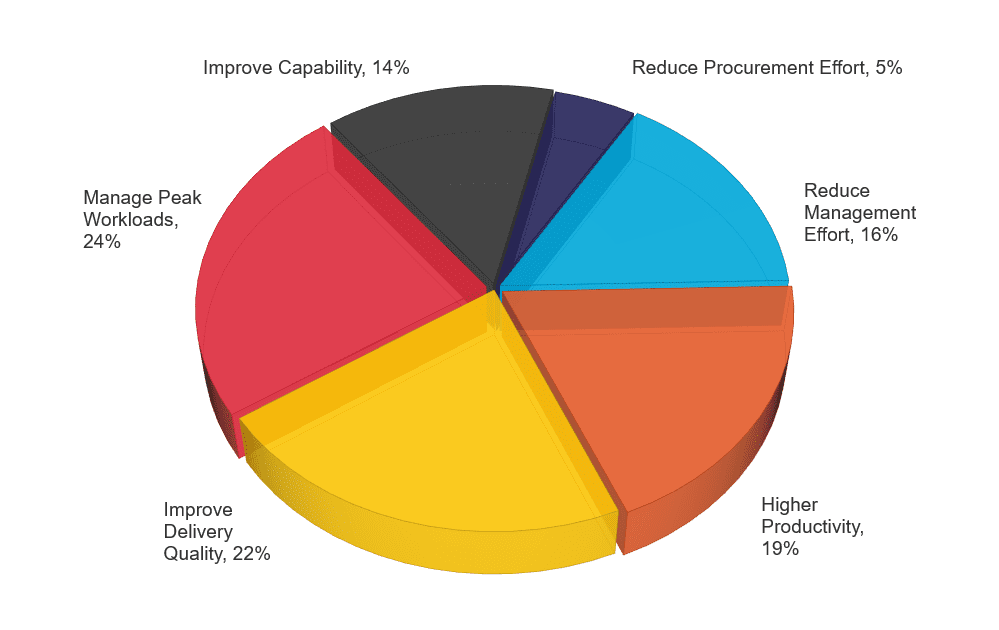What is Project Management as a Service (PMaaS) and why do you need it?
Project Management as a Service is not a new concept. Although it is only one solution in our project management services offering, it is rising in popularity. Over the past few years, we have seen the market shift from pure products-based companies to an influx of services-based companies. Project Management, already part of the services landscape, was not left untouched.
What is Project Management as a Service?
Project Management as a Service (often shortened to PMaaS) is an adaptable consulting service that allows clients to hire as many project managers as needed to see their projects through. The value of PMaaS is that clients can scale the amount of consultants up and down to fit their needs.
PMaaS differs from traditional consulting where the consultancy supplies the resources, but the client retains responsibility for the PMO operation and its performance.
PMaaS can take many shapes, sizes, and names in an organization, such as Managed Services or Project Management Office as a Service (PMOaas). However, they are basically all the same.
Using PMaaS to Lower Costs
Organizations have become accustomed to using managed services in many IT functions: running email, performing network management, and similar activities. These tend to be operations that are fairly stable but necessary.
Now, organizations are translating that need to work like Project Management and Change Management, where highly specialized expertise when hired in-house proves too costly.
Additionally, when outside the core competency of the organization, like start-up companies starting to scale, delivering that expertise in-house will require heavy investment in the necessary processes, procedures, and tools.
A managed service approach, like MIGSO-PCUBED’s Project Management as a Service (PMaaS), is a new way to mobilize flexible projects, programs, and change management services. The model is one where the partner manages all aspects of the service delivery including recruitment, onboarding, and training to drive cost efficiencies and increased organizational capability while improving project and program execution performance at pace. The organization doesn’t require headcount on the books, with the added advantage that the managed service provider is an expert in the service being delivered. You get capability and capacity when you need it.
With a managed service, the provider takes on the responsibility of managing project performance. In many cases, using a managed service supplier will even allow the client to pay less than he or she might have previously going piecemeal, as the pricing models are based on the specific services to be provided, and the volume and complexity of projects within the service.
But the key point is that PMaaS is more of a shift in mindset. As with most business today, you must evaluate how your organization can move from project management viewed from an operations-based approach with the focus on process; to a customer service based approach where the focus is on value.
Why Clients Move to PMaaS
Similar to the move to managed services for IT solutions, clients are looking for providers to remove some of the burdens of delivering support services, allowing them to focus on their core competency or what they do best. Clients may have many different reasons for wanting to move to a managed service model. It may not make sense in all situations, however, it could be considered in environments where one or more of these conditions exist:
- There are challenging, critical change initiatives where the company needs confidence in its PMO delivery.
- There’s a lack of capability or capacity to provide an effective PMO service in house.
- There’s a need for the stability brought about through having a single service provider.
- The organization is seeking greater PMO cost transparency and manageability.
- The constant churn of contractors is resulting in loss of knowledge and loss of time.
- The organization or program has a global reach that demands better coordination by a well-integrated and standardized global PMO.
- There’s a strong service management mentality in company operations.
- There’s a desire to develop internal PPM maturity by having the service embed standardized processes into operations that in the future can be subsumed by the company.
In order to understand the most compelling reason for moving to PMaaS, MIGSO-PCUBED surveyed more than 90 respondents across 50 companies as to why they were interested in Project Management as a Service.

Initially, we assumed that the majority of our clients would be concerned with reducing Procurement and Management Effort (21%). However, when looking at the results from the survey, we find that while this is a significant aspect, the ability to manage peak workloads (24%) and improve delivery quality (22%) are more of a consideration.
We see this play out in our engagements as well. We have been called in to deliver PMO managed services across industries and regions, in many different client situations. One client specifically wanted regular, on-time service reporting to provide its executives with visibility into project and program activities. This would allow the executives to drill into key factors that would influence their delivery quality.
Others focus on improving organizational efficiency. Using our Airbus case study as an example, we were able to save the client 20% in productivity by using managed service PMO staff. Finally, multiple organizations have called on our managed service team to set up and operate their PMOs for the duration of a specific critical program or project; improving their PMO capability.
Whatever the rationale for moving to a Managed Service approach, our focus is on delivering clear, demonstrable value back to the client organization.
Why is PMaaS a Model for the Future?
Project Management as a Service, as we highlighted above, represents a shift in mindset to a value-based approach with the customer or client at the center of your delivery. The approach requires you to understand what performance is required in order to achieve customer satisfaction.
It requires the project management resources to have a clear understanding of how they are tied to the strategic objectives of the organization. If the focus is on Project Efficiency, what can I do in my role to remove waste out of these processes for initiation or status reporting? What ways can we use technology to drive improvements in delivery? In today’s market and more importantly the future, it will be critical for organizations to focus on prioritizing activity, even project management activity, based on alignment to strategic imperatives and value.
Being a Project Management Consultancy, this is the core of our competency. We at MIGSO-PCUBED have spent over 25 years working with our clients to develop the people, process and tools necessary, continually investing in what comes next, so that we can help you deliver success. Each of our clients is unique in its needs and its challenges. That’s why we invested early in identifying scalable on-demand solutions giving you access to qualified resources so that you could do more. And that’s why we will continue to invest and innovate in this delivery model for the future.
Looking to transition to a Managed Service model? We can help. Yes, there is a standard transition that each client should go through. In our next post, we highlight those key steps that one should take in moving to a PMO Managed Service.
"They are also learning that project management isn't really their core competence, they could get someone to do that well, and in a way that really integrates with their business."
Jack, MIGSO-PCUBED Senior Consultant
Project Management as a Service (PMaaS) is an established approach to mobilize flexible project, program and change management services, guaranteeing quality and efficient delivery, on a planned portfolio of activities.







